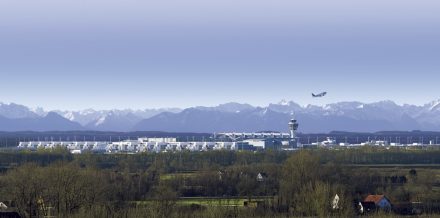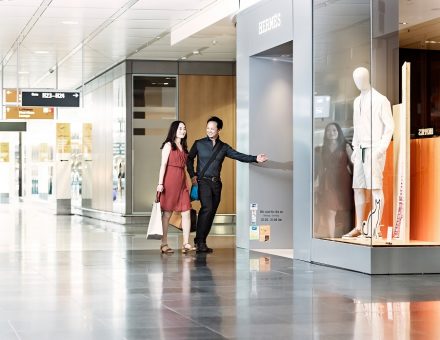
Munich is the European champion — or was at least given the title in the ranking from the “World Airport Awards”. On an international level, the airport came in at 3rd place, based on 13 million surveyed passengers.
What makes Munich Airport so popular? The quality of stay is a criterion. Roughly 8,000 employees work on keeping the airport in the upper ranks. Making sure that the Munich air traffic hub keeps up with the times and is able to continuously and positively surprise its visitors is the sole task of the Innovation Management department. Munich Startup interviewed Sarah Wittlieb, head of Innovation Management.
Goal: Shaping the USP and surprising with wow effects
Munich Airport would like to please passengers, those picking them up, shoppers and visitors not only with new events, but also with innovative services and products. The innovation team is able to give their all on this colorful playing field and “create wow effects for customers”. This is Wittlieb’s responsibility, and she definitely has her sights set on working with startups.
On one hand, the innovation manager checks to see how far along a startup is before starting a new collaboration. She is always looking for new products and services that can be tested quickly on the market. On the other hand, she evaluates the people in the company, the founders’ degree of professionalism and the structure of the team. Another factor she assesses is the founders’ willingness to tailor the product to the needs of the airport and the end customer.
Customer experience is the main focus, since “our job is to constantly surprise and fascinate,” explained Wittlieb. The economic viability of the idea is also just as important. Furthermore, the startup should pretty much be able to stand on their own two feet to make sure that the financing of the startup does not suddenly disappear. The airport does not provide its own venture capital.
Using their collaboration with NavVis as an example, Wittlieb elaborated:
We know from customer surveys that passengers want to know ahead of time: Where will I be arriving? Where will I have to go to board? What does the layout look like? Where will I find certain things? NavVis made it possible for us to show a 360° view. In addition to a positive customer experience, it is also exciting from a business point of view, because this is where our retail area is positioned. Both elements are interconnected, which is ideal.
Innovation management can just try things out

Intriguing: the innovation department has a budget that allows them to simply try out the most diverse ideas and projects. It is only after the pilot phase that both airport CEOs need to be sold on the idea of the new product or innovative service. Or perhaps not, since projects do not always make it through the pilot testing phase of four to six months. In cases where the innovation does not live up to the expectations and the cost-benefit calculation, pilot testing can also be terminated in advance.
Wittlieb’s advice for startups remains – or perhaps exactly in light of this fact, is – “Stay strong and hold on to your idea.” After all, major opportunities might be found in another industry or with a competitor.
It is true that solutions are actively sought out to solve existing challenges at the airport. However:
During pilot testing, I still cannot say ahead of time if it is going to work, even with an opportunity/risk analysis,
said Wittlieb. Nonetheless, she is still completely free on deciding what to do with the innovation budget and can easily try out something new.
At the same time, it is important to have your own team on board with you and not to operate from an “ivory tower of innovation management”. It is also a matter of
“[…], making sure people know that it is not so terrible if a project does not work.”
People should embrace the controversial culture of error within their own business and be ready to make changes.

Looking for trends
On the quest for new ideas, the airport employees go out in the world and bring the most varied of concepts back with them from exhibitions, startup events or other innovative companies. The ideas are compiled using a platform which was developed by a Munich startup that engages in crowdsourcing both in-house and externally.

The airport has also thrown a pitch event, which led to cooperation in creating Lounge Shopping with the Munich startup Wundery. “It is always a case of trial and error for us,” remarked Wittlieb. In this case, it worked very well. The startup was able to quickly and flexibly react to the airport’s needs.
Beyond an official pitch, Wittlieb and her team are open to hearing ideas from startups — so get in touch with her! Ideas are always in need in three different areas:
• The topic of “Future Mobility” is important to Munich Airport. Getting several cooperation partners, both established companies and startups, at one table concerning the concept of “intermodal travel” is also a focus. Several projects are currently in their test phases with airlines and startups.
• Real estate management is the second area of interest. It is equally interesting for both startups and large companies with a customer group of roughly 16 million business travelers each year (as of 2015).
• The third area in which innovative concepts are always welcome is retail and food service. Here, the emphasis is on interlinking digital and analog offers.
Learning from startups about bravery, agility and team dynamics
When asked about what established companies might be able to learn from startups, the passionate innovation manager named three things:
1. Be brave. All startups and founders were brave enough to launch their own company and believe in their ideas. That is something we can learn from startups: be brave, try something new and take a risk.
2. The speed at which things can be implemented. Instead of waiting for a 120% solution like German corporations.
3. Team dynamics. In comparison to companies with hierarchical structures, how things happen is very different.
Wittlieb tries to actively practice a lot of what she mentioned within her own team. She brings fresh energy to a company that otherwise thinks in major cycles and takes great care to keep risks as minimal as possible. For those of you who now feel like getting on a plane after reading this — vacation vibes are offered by the latest project: a travel blog by the name of Travellers Insight.
